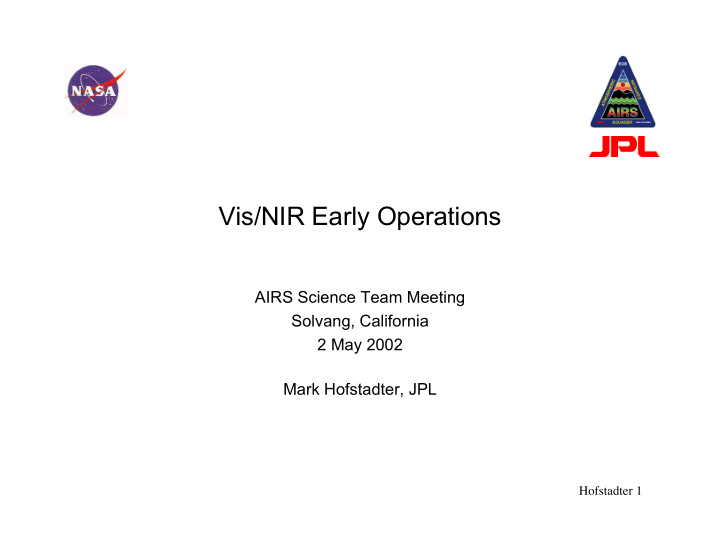



Vis/NIR Early Operations AIRS Science Team Meeting Solvang, California 2 May 2002 Mark Hofstadter, JPL Hofstadter 1
Vis/NIR Early Operations Summary • Vis data expected to start around launch +15 days. Variability index, radiance maps, and NDVI maps available immediately. • At launch, radiances are not calibrated. First calibrated radiances will start around 1 month after first-light. • Co-registration of the 4 Vis channels and rough Vis to IR co- registration approximately 1 month after first light. • Cloud detection over ocean expected to be working two months after first light. • Improved vicarious calibration, cloud detection over land, and improved co-registration ~4 months after first light. Hofstadter 2
Vis/NIR Early Operations At Launch Products Vis expected to start around launch +15. Variability indices, radiance maps, and NDVI maps available immediately. Daily NDVI (“VegMap”) Product. Hofstadter 3
Vis/NIR Early Operations At Launch Products (Continued) Multi-Day NDVI (“VegMap10X”) Product. Hofstadter 4
Vis/NIR Early Operations At Launch Products (Continued) Variability Index Radiance maps (Channel 1 shown) Hofstadter 5
Vis/NIR Early Operations Radiance Calibration At launch, radiances are not calibrated. First calibrated radiances will start around 1 month after first-light. • Initial vicarious calibration can use model-predicted surface and cloud reflectivities. • In addition, a MISR-Terra field campaign expects to be in Railroad Valley Playa, Nevada, from late May to Mid-July. They have agreed to support AIRS-Aqua overflights. Hofstadter 6
Vis/NIR Early Operations Radiance Calibration (Continued) Lunar Lake Playa, Nevada, as seen by AirMISR Hofstadter 7
Vis/NIR Early Operations Radiance Calibration (Continued) Hofstadter 8
Hofstadter 9
Vis/NIR Early Operations Initial Co-Registration/Geolocation Co-registration of the 4 Vis channels and rough Vis to IR coregistration approximately 1 month after first light. • Co-registration initially done “by hand”, using Vendaval tools allowing images to be overlaid and translated with respect to each other. • Absolute geolocation information from MISR data. • Expect accuracy ~ 0.5 pixel (1 km) among Vis channels. Hofstadter 10
Vis/NIR Early Operations Early Cloud Detection Cloud detection over ocean expected to be working two months after first light. • Detailed presentation given by UCSB at last science team meeting. True vs. Vis retrieved cloud fraction. Vis vs. IR retrieved cloud fraction. Hofstadter 11
Vis/NIR Early Operations Mid-Term Products Improved vicarious calibration, cloud detection over land, and improved co-registration ~4 months after first light. • Additional vicarious calibration activities. • Better radiances and development of surface NDVI maps improve cloud detection. • Minimization of image differences used to co- register/geolocate images to a fraction of a pixel. Hofstadter 12
Recommend
More recommend